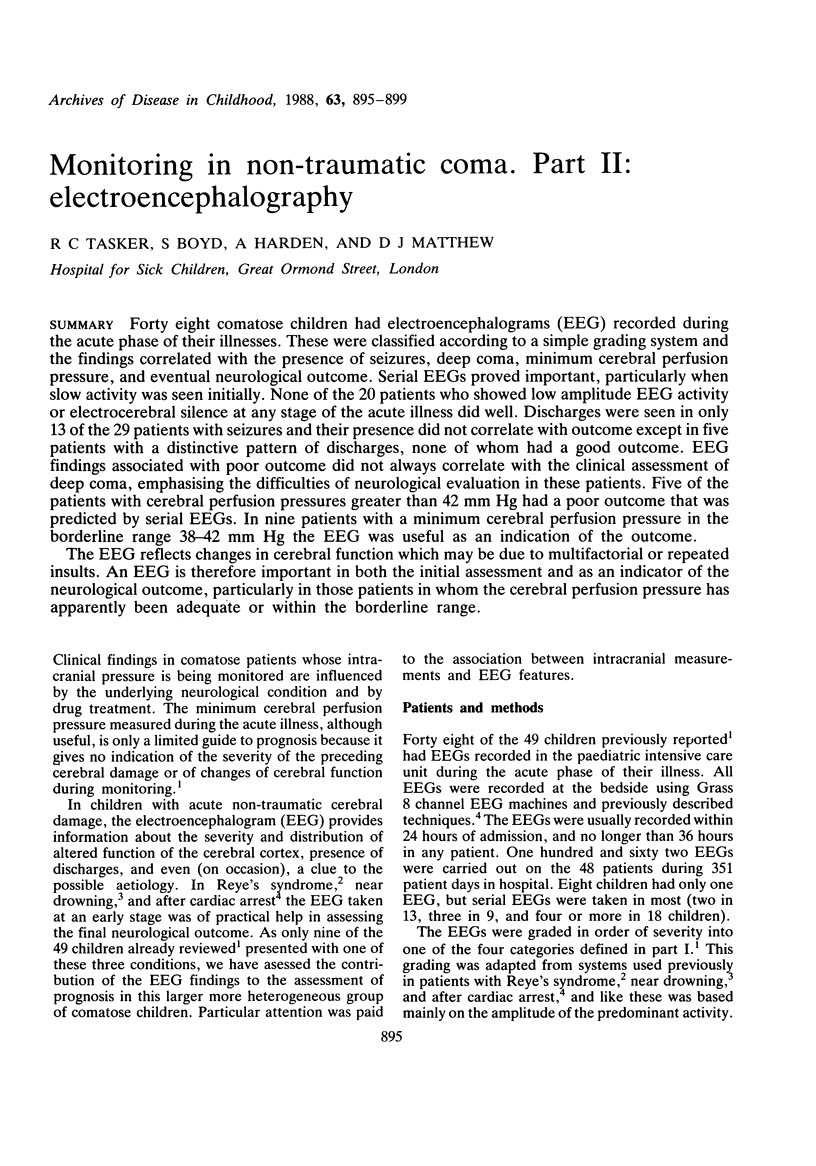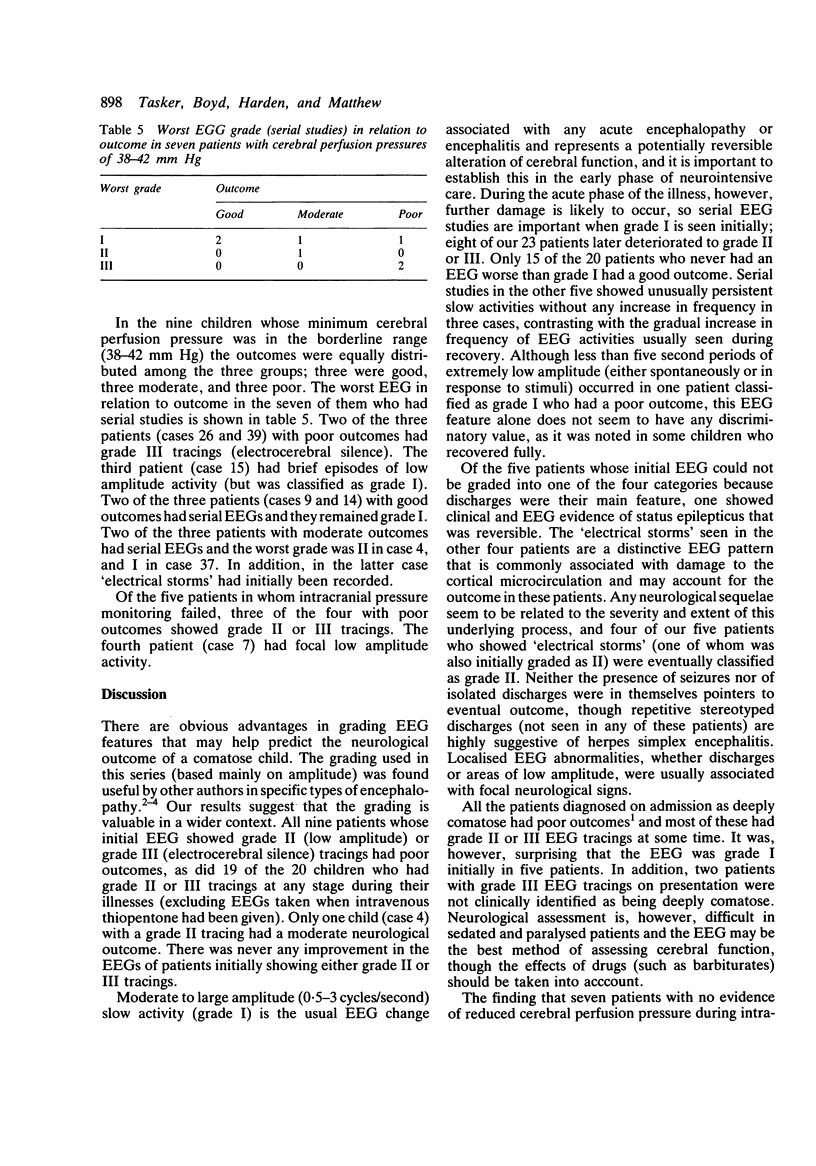Abstract
Forty eight comatose children had electroencephalograms (EEG) recorded during the acute phase of their illnesses. These were classified according to a simple grading system and the findings correlated with the presence of seizures, deep coma, minimum cerebral perfusion pressure, and eventual neurological outcome. Serial EEGs proved important, particularly when slow activity was seen initially. None of the 20 patients who showed low amplitude EEG activity or electrocerebral silence at any stage of the acute illness did well. Discharges were seen in only 13 of the 29 patients with seizures and their presence did not correlate with outcome except in five patients with a distinctive pattern of discharges, none of whom had a good outcome. EEG findings associated with poor outcome did not always correlate with the clinical assessment of deep coma, emphasising the difficulties of neurological evaluation in these patients. Five of the patients with cerebral perfusion pressures greater than 42 mm Hg had a poor outcome that was predicted by serial EEGs. In nine patients with a minimum cerebral perfusion pressure in the borderline range 38-42 mm Hg the EEG was useful as an indication of the outcome. The EEG reflects changes in cerebral function which may be due to multifactorial or repeated insults. An EEG is therefore important in both the initial assessment and as an indicator of the neurological outcome, particularly in those patients in whom the cerebral perfusion pressure has apparently been adequate or within the borderline range.
Full text
PDF




Selected References
These references are in PubMed. This may not be the complete list of references from this article.
- Aoki Y., Lombroso C. Prognostic value of electroencephalography in Reye's syndrome. Neurology. 1973 Apr;23(4):333–343. doi: 10.1212/wnl.23.4.333. [DOI] [PubMed] [Google Scholar]
- De Meirleir L. J., Taylor M. J. Prognostic utility of SEPs in comatose children. Pediatr Neurol. 1987 Mar-Apr;3(2):78–82. doi: 10.1016/0887-8994(87)90031-2. [DOI] [PubMed] [Google Scholar]
- Goff W. R., Shaywitz B. A., Goff G. D., Reisenauer M. A., Jasiorkowski J. G., Venes J. L., Rothstein P. T. Somatic evoked potential evaluation of cerebral status in Reye syndrome. Electroencephalogr Clin Neurophysiol. 1983 Apr;55(4):388–398. doi: 10.1016/0013-4694(83)90126-8. [DOI] [PubMed] [Google Scholar]
- Janati A., Erba G. Electroencephalographic correlates of near-drowning encephalopathy in children. Electroencephalogr Clin Neurophysiol. 1982 Feb;53(2):182–191. doi: 10.1016/0013-4694(82)90022-0. [DOI] [PubMed] [Google Scholar]
- Lütschg J., Pfenninger J., Ludin H. P., Vassella F. Brain-stem auditory evoked potentials and early somatosensory evoked potentials in neurointensively treated comatose children. Am J Dis Child. 1983 May;137(5):421–426. doi: 10.1001/archpedi.1983.02140310003001. [DOI] [PubMed] [Google Scholar]
- Markand O. N. Electroencephalography in diffuse encephalopathies. J Clin Neurophysiol. 1984 Oct;1(4):357–407. [PubMed] [Google Scholar]
- Maynard D. E., Jenkinson J. L. The cerebral function analysing monitor. Initial clinical experience, application and further development. Anaesthesia. 1984 Jul;39(7):678–690. doi: 10.1111/j.1365-2044.1984.tb06477.x. [DOI] [PubMed] [Google Scholar]
- Pampiglione G., Harden A. Resuscitation after cardiocirculatory arrest. Prognostic evaluation of early electroencephalographic findings. Lancet. 1968 Jun 15;1(7555):1261–1265. doi: 10.1016/s0140-6736(68)92287-3. [DOI] [PubMed] [Google Scholar]
- Tasker R. C., Matthew D. J., Helms P., Dinwiddie R., Boyd S. Monitoring in non-traumatic coma. Part I: Invasive intracranial measurements. Arch Dis Child. 1988 Aug;63(8):888–894. doi: 10.1136/adc.63.8.888. [DOI] [PMC free article] [PubMed] [Google Scholar]


